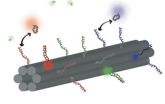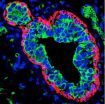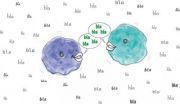(Press-News.org)
VIDEO:
DNA origami is a process that can be used to self-assemble shapes that are of nanometer dimensions -- 100 nanometers is about 1,000 times shorter than the width of an...
Click here for more information.
BOSTON, September 24, 2012—Much like the checkout clerk uses a machine that scans the barcodes on packages to identify what customers bought at the store, scientists use powerful microscopes and their own kinds of barcodes to help them identify various parts of a cell, or types of molecules at a disease site. But their barcodes only come in a handful of "styles," limiting the number of objects scientists can study in a cell sample at any one time.
Researchers at the Wyss Institute for Biologically Inspired Engineering at Harvard University have created a new kind of barcode that could come in an almost limitless array of styles—with the potential to enable scientists to gather vastly more vital information, at one given time, than ever before. The method harnesses the natural ability of DNA to self-assemble, as reported today in the online issue of Nature Chemistry.
"We hope this new method will provide much-needed molecular tools for using fluorescence microscopy to study complex biological problems," says Peng Yin, Wyss core faculty member and study co-author who has been instrumental in the DNA origami technology at the heart of the new method.
Fluorescence microscopy has been a tour de force in biomedical imaging for the last several decades. In short, scientists couple fluorescent elements—the barcodes—to molecules they know will attach to the part of the cells they wanted to investigate. Illuminating the sample triggers each kind of barcode to fluoresce at a particular wavelength of light, such as red, blue, or green—indicating where the molecules of interest are.
However, the method is limited by the number of colors available—three or four—and sometimes the colors get blurry. That's where the magic of the DNA barcode comes in: colored-dots can be arranged into geometric patterns or fluorescent linear barcodes, and the combinations are almost limitless—substantially increasing the number of distinct molecules or cells scientists can observe in a sample, and the colors are easy to distinguish.
Here's how it works: DNA origami follows the basic principles of the double helix in which the molecular bases A (adenosine) only bind to T (thymine), and C (cytosine) bases only bind to G (guanine). With those "givens" in place, a long strand of DNA is programmed to self-assemble by folding in on itself with the help of shorter strands to create predetermined forms—much like a single sheet of paper is folded to create a variety of designs in the traditional Japanese art.
To these more structurally complex DNA nano-structures, researchers can then attach fluorescent molecules to the desired spots, and use origami technology to generate a large pool of barcodes out of only a few fluorescent molecules. That could add a lot to the cellular imaging "toolbox" because it enables scientists to potentially light up more cellular structures than ever possible before.
"The intrinsic rigidity of the engineered DNA nanostructures is this method's greatest advantage; it holds the fluorescent pattern in place without the use of external forces. It also holds great promise for using the method to study cells in their native environments," Yin says. As proof of concept, the team demonstrated that one of their new barcodes successfully attached to the surface of a yeast cell.
More research beckons, particularly to determine what happens when each of the fluorescent barcodes are mixed together in a cell sample, which is routine in real-life biological and medical imaging systems—but there's plenty of good news as a starting point. It's low-cost, easy to do, and more robust compared to current methods, says Yin.
"We're moving fast in our ability to manipulate DNA molecules using origami technology," says Wyss Institute Founding Director Don Ingber, M.D., Ph.D., "and the landscape of its potential is tremendous—from helping us to develop targeted drug-delivery mechanisms to improving the scope of cellular and molecular activities we are able to observe at a disease site using the latest medical imaging techniques."
INFORMATION:
The research team was led by three Wyss Founding Core Faculty members: Peng Yin, Ph.D., William Shih, Ph.D., and George Church, Ph.D. Yin is also an Assistant Professor of Systems Biology at Harvard Medical School (HMS). Church is also Professor of Genetics at HMS and Professor of Health Sciences and Technology at Harvard and the Massachusetts Institute of Technology. Shih is an Associate Professor in the Department of Biological Chemistry and Molecular Pharmacology at HMS and the Department of Cancer Biology at the Dana-Farber Cancer Institute. Other research contributors included Chenxiang Lin, Ph.D., now Assistant Professor of Cell Biology at Yale School of Medicine; Wyss Institute Postdoctoral Scholar Ralf Jungmann, Ph.D.; Wyss Staff Scientist Chao Li, Ph.D.; Wyss Senior Staff Scientist Daniel Levner, Ph.D.; and Andrew Leifer, Ph.D., formerly at Harvard University, who is now a Lewis-Sigler Fellow at Princeton University.
The work was funded by the National Institutes of Health, the National Science Foundation, the Office of Naval Research, and the Wyss Institute.
For more information, contact Kristen Kusek (Kristen.kusek@wyss.harvard.edu, +1 617-432-8266).
IMAGES AVAILABLE
About the Wyss Institute for Biologically Inspired Engineering at Harvard University
The Wyss Institute for Biologically Inspired Engineering at Harvard University (http://wyss.harvard.edu) uses Nature's design principles to develop bioinspired materials and devices that will transform medicine and create a more sustainable world. Working as an alliance among Harvard's Schools of Medicine, Engineering, and Arts & Sciences, and in partnership with Beth Israel Deaconess Medical Center, Brigham and Women's Hospital, Boston Children's Hospital, Dana Farber Cancer Institute, Massachusetts General Hospital, the University of Massachusetts Medical School, Spaulding Rehabilitation Hospital, Boston University and Tufts University, the Institute crosses disciplinary and institutional barriers to engage in high-risk research that leads to transformative technological breakthroughs. By emulating Nature's principles for self-organizing and self-regulating, Wyss researchers are developing innovative new engineering solutions for healthcare, energy, architecture, robotics, and manufacturing. These technologies are translated into commercial products and therapies through collaborations with clinical investigators, corporate alliances, and new start-ups.
Researchers at Harvard's Wyss Institute engineer novel DNA barcode
New technology could launch biomedical imaging to next level
2012-09-24
ELSE PRESS RELEASES FROM THIS DATE:
Study uncovers mechanism by which tumor suppressor MIG6 triggers cell suicide
2012-09-24
New York, NY and Uppsala, Sweden, September 24, 2012 – Death plays a big role in keeping things alive. Consider the tightly orchestrated suicide of cells--a phenomenon essential to everything from shaping an embryo to keeping it free of cancer later in life. When cells refuse to die, and instead multiply uncontrollably, they become what we call tumors. An intricate circuitry of biochemical reactions inside cells coordinates their self-sacrifice. Tracing that circuitry is, naturally, an important part of cancer research.
In a major contribution to that effort Dr. Ingvar ...
New study shows PTSD symptoms reduced in combat-exposed military via integrative medicine
2012-09-24
SAN DIEGO (Sept. 24, 2012) – Healing touch combined with guided imagery (HT+GI) provides significant clinical reductions in post-traumatic stress disorder (PTSD) symptoms for combat-exposed active duty military, according to a study released in the September issue of Military Medicine.
The report finds that patients receiving these complementary medicine interventions showed significant improvement in quality of life, as well as reduced depression and cynicism, compared to soldiers receiving treatment as usual alone.
The study, led by the Scripps Center for Integrative ...
Pacific Islanders have high obesity, smoking rates
2012-09-24
ANN ARBOR, Mich.—In the first study to detail the health of Pacific Islanders living in the United States, University of Michigan researchers have found alarmingly high rates of obesity and smoking.
The preliminary findings are being presented today (Sept. 24) at a conference in Los Angeles on health disparities among Native Hawaiians and Pacific Islanders.
"Native Hawaiians and Pacific Islanders are the second fastest growing minority population in the U.S.," said Sela Panapasa, a researcher at the U-M Institute for Social Research and principal investigator of the ...
Vitamin D deficiency increases risk of heart disease
2012-09-24
New research from the University of Copenhagen and Copenhagen University Hospital shows that low levels of vitamin D are associated with a markedly higher risk of heart attack and early death. The study involved more than 10,000 Danes and has been published in the well-reputed American journal Arteriosclerosis, Thrombosis and Vascular Biology.
Vitamin D deficiency has traditionally been linked with poor bone health. However, the results from several population studies indicate that a low level of this important vitamin may also be linked to a higher risk of ischemic heart ...
Climate is changing the Great Barrier Reef
2012-09-24
Satellite measurement of sea surface temperatures has yielded clear evidence of major changes taking place in the waters of Australia's Great Barrier Reef over the past 25 years, marine scientists have found.
The changes have big implications for the future management of the GBR and its marine protected areas say Dr Natalie Ban and Professor Bob Pressey of the ARC Centre of Excellence for Coral Reef Studies and James Cook University, who led the study with Dr Scarla Weeks from the University of Queensland.
"When we looked back at satellite data collected since 1985, ...
World Heart Federation says heart health starts earlier than you think
2012-09-24
A new multi-national survey reveals the extent of misconceptions about when is the right time to start taking action to prevent cardiovascular disease (CVD). In a four-country survey sample of 4,000 adults, 49 per cent answered age 30 years or older when asked at what age they believe people should start to take action about their heart health to prevent conditions such as heart disease and stroke. The fact is that CVD can affect people of all ages and population groups, and the risk begins early in life through unhealthy diets, lack of physical activity and exposure to ...
Cellular eavesdropping made easy
2012-09-24
It is much harder to keep up with a conversation in a crowded bar than in a quiet little café, but scientists wishing to eavesdrop on cells can now do so over the laboratory equivalent of a noisy room. A new method devised by scientists at the European Molecular Biology Laboratory (EMBL) in collaboration with the German Cancer Research Centre (DKFZ), both in Heidelberg, Germany, provides a new approach for studying the proteins cells release to communicate with each other, react to changes, or even to help them move. Published online today in Nature Biotechnology, the work ...
New IVF breakthrough
2012-09-24
Researchers at the University of Gothenburg have discovered that a chemical can trigger the maturation of small eggs to healthy, mature eggs, a process that could give more women the chance of successful IVF treatment in the future. The results have been published in the revered journal PloS ONE.
Women and girls treated for cancer with radiotherapy and chemotherapy are often unable to have children as their eggs die as a result of the treatment.
Although it is now possible to freeze eggs and even embryos, this is not an option for girls who have yet to reach puberty. ...
Immune system molecule affects our weight
2012-09-24
Researchers at the Sahlgrenska Academy, University of Gothenburg, Sweden, have identified a molecule in the immune system that could affect hunger and satiety. The researchers hope that new treatments for obesity will benefit from this finding.
Interleukin-6 is a chemical messenger in our immune system that plays an important role in fighting off infection. However, recent research has, surprisingly, shown that it can also trigger weight loss. Researchers at Sahlgrenska Academy, University of Gothenburg, have been investigating and managed to identify the specific types ...
New back pain gene identified in largest genetic study of its kind
2012-09-24
Researchers at King's College London have for the first time identified a gene linked to age-related degeneration of the intervertebral discs in the spine, a common cause of lower back pain.
Costing the UK an estimated £7billion a year due to sickness leave and treatment costs, the causes of back pain are not yet fully understood. Until now, the genetic cause of lower back pain associated with lumbar disc degeneration (LDD) was unknown, but the largest study to date, published this week in the journal Annals of Rheumatic Diseases, has revealed an association with the ...
LAST 30 PRESS RELEASES:
Post-stroke injection protects the brain in preclinical study
Cardiovascular risk score predicts multiple eye diseases
Health: estimated one in ten British adults used or interested in GLP-1 medications for weight loss
Exercise to treat depression yields similar results to therapy
Whooping cough vaccination for pregnant women strengthens babies’ immune system
Dramatic decline in new cases of orphanhood in Uganda driven by HIV treatment and prevention programs
Stopping weight loss drugs linked to weight regain and reversal of heart health markers
Higher intake of food preservatives linked to increased cancer risk
Mass General Brigham–developed cholera vaccine completes phase 1 trial
First experimental validation of a “150-year-old chemical common sense” direct visualization of the molecular structural changes in the ultrafast anthracene [4+4] photocycloaddition reaction
Lack of support for people on weight loss drugs leaves them vulnerable to nutritional deficiencies, say experts
Dogs’ dinners can have greater climate impact than owners’
Are you ready to swap salmon for sprats and sardines?
1.6 million UK adults used weight loss drugs in past year
American College of Cardiology comments on new dietary guidelines for Americans
American Society of Gene & Cell Therapy and Orphan Therapeutics Accelerator partner to advance and commercialize promising rare disease treatments
One in 14 patients having day case surgery have new or worse chronic pain 3 months after their operation
New study highlights link between eviction rates and gun violence
Heatwaves heat up soil but not toxin levels in rice, study finds
Digital modeling reveals where construction carbon emissions really come from
Turning farm waste into water filters
New study shows how the spleen helps the immune system accept a transplant
New Mayo Clinic study advances personalized prostate cancer education with an EHR-integrated AI agent
Researchers identify novel therapeutic target to improve recovery after nerve injury
Microbes in breast milk help populate infant gut microbiomes
Reprogramming immunity to rewrite the story of Type 1 diabetes
New tool narrows the search for ideal material structures
Artificial saliva containing sugarcane protein helps protect the teeth of patients with head and neck cancer
Understanding the role of linear ubiquitination in T-tubule biogenesis
Researchers identify urban atmosphere as primary reservoir of microplastics
[Press-News.org] Researchers at Harvard's Wyss Institute engineer novel DNA barcodeNew technology could launch biomedical imaging to next level


